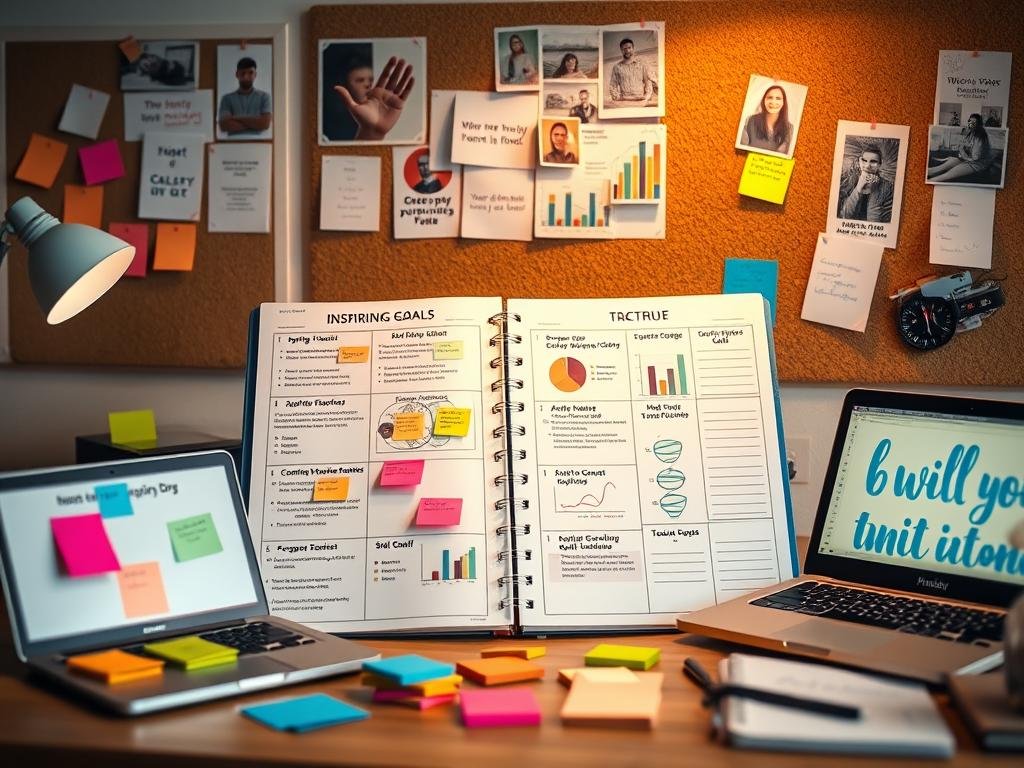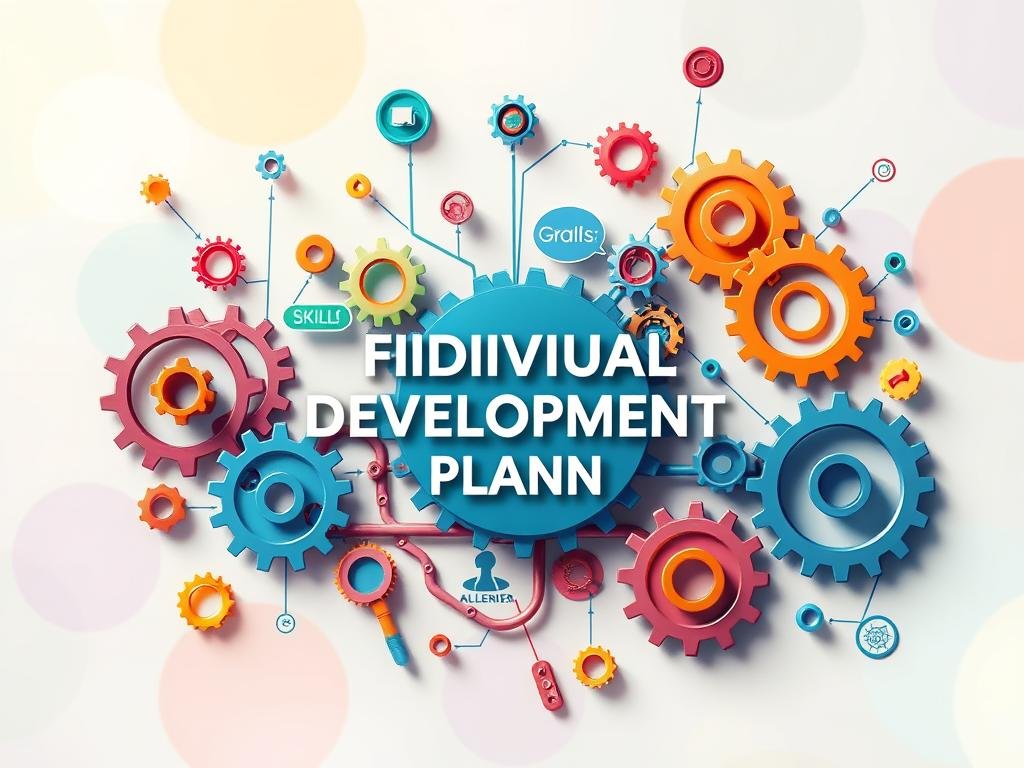Are you ready to take control of your career and unlock your true potential? An Individual Development Plan (IDP) can be the game-changer you’ve been looking for. This strategic roadmap will empower you to identify your strengths, address your development needs, and pursue your professional aspirations with laser-sharp focus. But where do you begin?
Key Takeaways
- An IDP helps you align your career goals with your employer’s objectives, ensuring mutual success.
- Proactive planning through an IDP can boost your job satisfaction, productivity, and long-term career prospects.
- Collaborating with your manager on an IDP fosters open communication and strengthens your professional relationship.
- An IDP serves as a roadmap for continuous learning and development, empowering you to take charge of your career growth.
- Regularly reviewing and updating your IDP ensures it remains relevant and helps you adapt to evolving industry demands.
What is an Individual Development Plan?
An individual development plan (IDP) is a valuable tool that outlines your career goals and the steps you need to take to achieve them. It also helps you identify your strengths and areas for growth, empowering you to take an active role in your professional development.
Key Benefits of an IDP
Crafting an IDP can provide numerous benefits to your career growth. It can help you:
- Inventory your strengths and pinpoint any gaps in your knowledge, skills, or experience.
- Establish both short-term and long-term goals that can drive you towards action.
- Visualize how to allocate your time and resources to work on specific development objectives.
- Celebrate milestones along the way, fostering a sense of accomplishment and momentum.
- Document your progress through regular assessment and reflection.
According to Lattice research, many employees, especially younger workers, are seeking jobs with clear growth opportunities and career progression transparency. Developing an IDP can be a valuable tool to demonstrate your commitment to continuous learning and professional goals.
“IDPs foster an open dialogue between managers and employees on how to bring out the best in employees and emphasize manageable but meaningful development strategies,” noted Bonnie Davis, a founding partner and consultant at a Colorado-based coaching and consulting firm.
By creating an individual development plan, you can take control of your career growth and align your professional goals with the needs of your organization, ultimately enhancing your employee development and talent management.

Steps to Develop Your Individual Development Plan
Crafting an individual development plan (IDP) is a crucial step in your career planning and skill development. This process involves several key stages to ensure your professional growth aligns with your personal goals and your organization’s needs.
First, take the time to explicitly define your career aspirations. Make a list of three to four jobs, in order of preference, that you would like to pursue after completing your degree. This exercise will help you identify the necessary skills and knowledge required for your desired career path(s).
Next, assess your current skills, talents, and abilities, and compare them to the requirements you outlined for your target roles. This self-assessment will enable you to create detailed, professional development goals for the short term (next year), mid-term (next 1–2 years), and long-term (3–5 years).
- Identify your career goals and preferences
- Assess your current skills and abilities
- Set SMART development goals for the short, mid, and long term
- Develop an action plan to achieve your goals
- Track your progress and adjust your plan as needed
Finally, it’s important to track your development and set new goals as you learn and grow. Regularly reviewing and updating your IDP will ensure your continuous learning and keep you on the path to achieving your performance management and career planning objectives.
“A strong career development program is one of the top benefits employees are looking for.”
By following these steps, you’ll create a comprehensive training roadmap that supports your skill development and helps you reach your individual development plan goals.
Identify Your Career Goals and Motivations
Developing a successful Individual Development Plan (IDP) begins with identifying your career goals and professional motivations. Take time to reflect on what energizes and inspires you at work. Consider the types of opportunities you desire in the future and the ones available in your current role that can foster your growth and development.
Examine where your personal motivations and the organization’s needs strongly align. Determine what skills or knowledge you want to acquire to prepare for your desired career path. Having a clear understanding of your career goals and driving motivations will help you create a focused IDP that aligns with your professional aspirations.
| Key Factors to Consider | Potential Benefits |
|---|---|
|
|
By clearly defining your career goals and professional motivations, you can create a comprehensive IDP that serves as a roadmap for your professional development and advancement within the organization.
Assess Your Strengths and Opportunities
To create an effective Individual Development Plan (IDP), you need to assess your strengths and development opportunities. Identify your talents, strengths, and passions, and compare them to the requirements of your desired career path. Review any performance-related feedback you’ve received from your supervisor, co-workers, or clients to gain an outside perspective on your strengths and areas for improvement.
Creating an Action Plan
Once you’ve identified your strengths and development opportunities, you can create an action plan that focuses on building on your strengths, preparing for new opportunities, and addressing your areas for growth. Your action plan should include specific, measurable, achievable, relevant, and time-bound (SMART) steps to help you achieve your IDP goals.
By assessing your strengths assessment and development opportunities, you can develop a comprehensive action planning strategy to drive your performance management and continuous learning. This will empower you to make meaningful progress towards your professional aspirations.
“Individuals across various industries benefit from creating an Individual Development Plan (IDP) that outlines professional goals, strengths, areas for improvement, and strategies for career growth.”
Remember, your IDP should be a living document that you revisit and update regularly. By regularly reviewing and updating your plan, you can ensure that it continues to align with your evolving goals and the changing needs of your organization.
| Key Benefits of an IDP | Statistics |
|---|---|
| – Promotes ongoing conversations between employees and managers | – Individuals with IDPs are 6x more likely to be engaged in their job |
| – Tailors growth strategies to individual strengths and aspirations | – IDP users are 6x more likely to strongly agree they can do their best every day |
| – Contributes to organizational agility through diverse employee skills | – IDP users are 3x more likely to report an excellent quality of life |
Implement and Track Your Plan
The final step in developing your individual development plan (IDP) is to put it into action and monitor your progress. After finalizing your IDP with your manager, schedule the plan’s deadlines into your calendar and take ownership of its execution. Partner with your manager to ensure you have the necessary resources and support to achieve your goals.
Regularly schedule check-in meetings with your manager to discuss your IDP implementation progress and make any necessary adjustments. Continuous self-assessment and improvement are central to an effective, useful IDP. As you learn and develop your abilities, be sure to set new goals to challenge yourself and keep your professional growth on track.
Measuring and Tracking Your Progress
To effectively implement and track your IDP, consider the following strategies:
- Break down your long-term goals into smaller, measurable milestones to track your progress tracking and performance management.
- Schedule regular check-ins with your manager to discuss your IDP implementation and make any necessary adjustments.
- Utilize self-assessment tools, such as personality tests or skills inventories, to identify areas for continuous learning and professional development.
- Seek feedback from your manager, colleagues, or mentors to gain valuable insights and perspectives on your progress.
By consistently monitoring your IDP and making adjustments as needed, you can ensure that your professional development efforts remain relevant and impactful, ultimately supporting your long-term career goals.
“An IDP is not a one-time exercise, but an ongoing process that requires regular review and refinement. Staying committed to your plan and adapting it as your needs and goals evolve is key to maximizing its effectiveness.”
Conclusion
Crafting an individual development plan (IDP) is a powerful tool in taking charge of your career growth and achieving your professional aspirations. By defining your career goals, assessing your strengths and areas for improvement, and creating a strategic action plan, you can make meaningful strides towards your desired future. Remember to regularly review and update your IDP, collaborating with your manager to ensure you have the support and resources needed to succeed.
With a focused, personalized IDP, you can navigate the ever-evolving work landscape and reach new heights in your career. In fact, 68% of workers indicate they would remain with their company if given opportunities for. By emphasizing employee development through IDPs, organizations can foster a positive culture that promotes open communication, collaboration, and a unified drive towards success.
So, take control of your career growth and unlock your full potential with an individual development plan tailored to your unique goals and capabilities. With dedication and a commitment to continuous learning, you can make remarkable progress and contribute to the success of your organization.
FAQ
What is an individual development plan (IDP)?
What are the key benefits of developing an IDP?
What are the steps to develop an effective IDP?
How do I identify my career goals and motivations for an IDP?
How do I assess my strengths and development opportunities for an IDP?
How do I implement and track my IDP?
Source Links
- A guide to creating a successful individual development plan | Culture Amp – https://www.cultureamp.com/blog/individual-development-plan-guide
- Individual Development Plan – Training and Development Policy Wiki – https://www.opm.gov/wiki/training/individual-development-plans.ashx
- What are Individual Development Plans and How Do They Empower Employee Success? – https://lattice.com/library/what-are-individual-development-plans-and-how-do-they-work
- Individual Development Plans – https://www.commerce.gov/hr/employees/learning-and-development/idp
- Individual Development Plan (IDP) Process – https://chr.ucla.edu/training/individual-development-plan
- Your guide to individual development plans (with examples) – https://www.betterup.com/blog/individual-development-plan
- How to Create Individual Development Plans (+ Example) | Spike – https://www.spikenow.com/blog/tips-tricks/career-growth-leveled-up-unveiling-the-power-of-individual-development-plans/
- Individual Development Plan: A Comprehensive Guide to Achieving Professional Growth – https://www.linkedin.com/pulse/individual-development-plan-comprehensive-guide-achieving-zdtrf
- Mastering the Individual Development Plan (IDP) in 5 Simple Steps – https://peoplespheres.com/mastering-the-individual-development-plan/
- Building Your Individual Development Plan (IDP): A Guide for Undergraduate Students – https://medium.com/stem-and-culture-chronicle/building-your-individual-development-plan-idp-a-guide-for-undergraduate-students-f14feca9111c
- Individual Development Plan – Job Aid – http://docs-do-not-link.udc.edu/hr/IDP-Job-Aid-Final-11-30-18.pdf
- Individual development plan examples: How to craft a roadmap to success – https://www.culturemonkey.io/employee-engagement/individual-development-plan-examples/
- How to Develop and Improve Your Strengths – https://www.gallup.com/cliftonstrengths/en/402029/how-to-develop-improve-strengths.aspx
- Individual Development Plan – IDP – Graduate School – https://graduateschool.colostate.edu/professional-development/idp/
- Write a Professional Development Plan in 6 Steps [2024] • Asana – https://asana.com/resources/professional-development-plan
- PDF – https://hr.tcnj.edu/wp-content/uploads/sites/128/2021/04/TCNJ-Individual-Development-Plan-Guide-2021.pdf
- APA’s resource for individual development plans (IDP) – https://www.apa.org/education-career/guide/individual-development-plan
- The Ultimate Guide: Implementing An Individual Development Plan by LAVINIA MEHEDINȚU – https://www.offbeat.works/post/the-ultimate-guide-implementing-an-individual-development-plan
- Creating Individual Development Plans (+Template) – https://www.paylocity.com/resources/resource-library/blog-post/individual-development-plan/






